|
|
|
Sort Order |
|
|
|
Items / Page
|
|
|
|
|
|
|
| Srl | Item |
| 1 |
ID:
132634
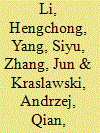

|
|
|
|
|
| Publication |
2014.
|
| Summary/Abstract |
To alleviate the problem of the insufficient reserves of natural gas in China, coal-based synthetic natural gas (SNG) is considered to be a promising option as a source of clean energy, especially for urban use. However, recent study showed that SNG will not accomplish the task of simultaneous energy conservation and CO2 reduction. In this paper, life cycle costing is made for SNG use in three main applications in residential sector: heating, household use, and public transport. Comparisons are conducted between SNG and coal, natural gas, liquefied petroleum gas (LPG), diesel, and methanol. The results show that SNG is a competitive option only for household use. The use of SNG for heating boilers or city buses is not as cost-effective as expected. The biggest shortcoming of SNG is the large amount of pollutants generated in the production stage. At the moment, the use of SNG is promoted by the government. However, as shown in this paper, one can expect a transfer of pollution from the urban areas to the regions where SNG is produced. Therefore, it is suggested that well-balanced set of environmental damage-compensating policies should be introduced to compensate the environmental losses in the SNG-producing regions.
|
|
|
|
|
|
|
|
|
|
|
|
|
|
|
|
| 2 |
ID:
177490
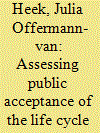

|
|
|
|
|
| Summary/Abstract |
Reducing the high CO2 emissions from the transportation sector requires alternatives to current fossil-based power trains. One possible approach is the development of alternative fuels produced from CO2, water, and renewable energy. Besides technological feasibility of required process steps (CO2 capture, CO2 transport, fuel production infrastructure), a successful adoption requires acceptance of alternative CO2-based fuels and their infrastructure. This study focuses on public acceptance of CO2-based fuels' life cycle by laypeople (N = 325) using conjoint analysis. The laypeople evaluated life cycle scenarios consisting of diverse options regarding CO2 capture, transport, and production infrastructure. To analyze the impact of information on acceptance evaluations, all respondents received information on energy efficiency and environmental impact of the process step options (2nd evaluation stage). The results revealed that CO2 source and transport are most relevant for participants' decisions. Significant impacts of information were found: higher levels of information changed extremely the evaluation of the CO2 capture options (e.g., air capture, chemical plant). The results highlight the importance of investigating laypeople's evaluations of life cycle scenarios, emphasize the relevance of providing adequate information to laypeople, and enable to derive information recommendations to reach a sustained public adoption of alternative fuels and their life cycle.
|
|
|
|
|
|
|
|
|
|
|
|
|
|
|
|
| 3 |
ID:
138104


|
|
|
|
|
| Summary/Abstract |
This paper uses a panel data-fixed effect approach and data collected from Chinese public manufacturing firms between 1999 and 2011 to investigate the impacts of business life cycle stages on capital structure. We find that cash flow patterns capture more information on business life cycle stages than firm age and have a stronger impact on capital structure decision-making. We also find that the adjustment speed of capital structure varies significantly across life cycle stages and that non-sequential transitions over life cycle stages play an important role in the determination of capital structure. Our study indicates that it is important for policy-makers to ensure that products and financial markets are well-balanced.
|
|
|
|
|
|
|
|
|
|
|
|
|
|
|
|
| 4 |
ID:
122718
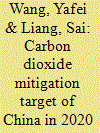

|
|
|
|
|
| Publication |
2013.
|
| Summary/Abstract |
China proposed a CO2 mitigation target in 2020 to deal with anthropogenic global climate change. Chinese policy makers mainly focus on three factors comprising consumption structure changes, energy technology development, and new energy increments. In addition, sectoral CO2 reduction is increasingly concerned in the world. Thus, it is significant to investigate integrated impacts of three factors to China's CO2 mitigation target as well as to identify key economic sectors for achieving this target. In this study, energy demand and CO2 emission in 2020 are predicted. Five scenarios are generated to illustrate the contributions of three factors. In addition, twelve key economic sectors for reducing energy demand and CO2 emission are identified from both production and final demand perspectives. Under integrated impacts of three factors, China's CO2 intensity per unit gross domestic product in 2020 will decrease by about 43.9% in 2020 than 2005 level. In the short term, China's CO2 mitigation will be highly dependent on energy technology development. In the long term, it will mainly rely on reshaped consumption structure changes and new energy development. In addition, China's future policies should focus on 12 identified key economic sectors.
|
|
|
|
|
|
|
|
|
|
|
|
|
|
|
|
| 5 |
ID:
147798
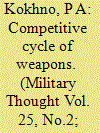

|
|
|
|
|
| Summary/Abstract |
The author studies the arms life cycle within his theory of the competitive cycle, i.e. its economic efficiency from production of items according to their intended purpose and further utilization. The author proves the necessity of application of methods to assess the full cost of arms supplied to the troops.
|
|
|
|
|
|
|
|
|
|
|
|
|
|
|
|
| 6 |
ID:
105797
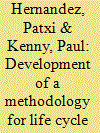

|
|
|
|
|
| Publication |
2011.
|
| Summary/Abstract |
Traditionally the majority of building energy use has been linked to its operation (heating, cooling, lighting, etc.), and much attention has been directed to reduce this energy use through technical innovation, regulatory control and assessed through a wide range of rating methods. However buildings generally employ an increasing amount of materials and systems to reduce the energy use in operation, and energy embodied in these can constitute an important part of the building's life cycle energy use. For buildings with 'zero-energy' use in operation the embodied energy is indeed the only life cycle energy use. This is not addressed by current building energy assessment and rating methods.
This paper proposes a methodology to extend building energy assessment and rating methods accounting for embodied energy of building components and systems. The methodology is applied to the EU Building Energy Rating method and, as an illustration, as implemented in Irish domestic buildings. A case study dwelling is used to illustrate the importance of embodied energy on life cycle energy performance, particularly relevant when energy use in operation tends to zero. The use of the Net Energy Ratio as an indicator to select appropriate building improvement measures is also presented and discussed.
|
|
|
|
|
|
|
|
|
|
|
|
|
|
|
|
| 7 |
ID:
173713
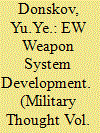

|
|
|
|
|
| Summary/Abstract |
This paper looks at issues of rationally managing the development of the weapon systems in electronic warfare (EW), including the tasks of making a system of control over the complete life cycle of EW equipment and methodological support of hardware items at the initial stages of the life cycle, R&D. It shows that to optimize the costs of the item's life cycle it is necessary to take into account not only its performance characteristics, but also its constructive and operational indices.
|
|
|
|
|
|
|
|
|
|
|
|
|
|
|
|
| 8 |
ID:
162328


|
|
|
|
|
| Summary/Abstract |
We quantify the greenhouse-gas mitigation potential and carbon abatement costs if green waste in the metropolitan region of Berlin, Germany, is diverted from composting into the production of hydrothermally carbonized coal (HTC coal) that is used to substitute for hard coal in electricity and heat generation. Depending on the origin of the green waste, we specify an urban, a rural-urban, and a rural scenario. All scenarios combined can mitigate 70,511 metric tons (t) of carbon-dioxide equivalents (CO2e) per year. The carbon abatement costs reach 163 €/t CO2e in the urban scenario, 76 €/t CO2e in the rural-urban scenario, and 77 €/t CO2e in the rural scenario. The lower abatement costs in the latter two scenarios are mainly due to HTC-coal co-firing in an existing power plant rather than constructing a new biomass power plant for HTC-coal mono-firing as in the urban scenario. While the abatement costs exceed the current carbon prices, they compare more favorably with commonly assumed damage costs of unmitigated climate change. Thus, the public support of HTC coal could be considered, with the primary policy focus on HTC-coal co-firing. HTC-coal co-firing could also lower the emissions of existing power plants during the fossil-fuel phase-out.
|
|
|
|
|
|
|
|
|
|
|
|
|
|
|
|
| 9 |
ID:
097377


|
|
|
| 10 |
ID:
088057


|
|
|
|
|
| Publication |
2009.
|
| Summary/Abstract |
Life cycle analysis of mercury in discarded low energy efficiency fluorescent lamps (36 W) and of HCFC in air-conditioners (12,000 Btu) removed from service has been conducted in this study. The objective was to find out the environmental impact (EDIP 1997 category, waste evaluation) of the products that appear in the waste stream as a result of facility upgrades. The scope of the study starts from retrofitting of the lamps and air-conditioners through recycling and disposal. For a 36 W fluorescent lamp, the bulk waste 1.64E?5 kg, hazardous waste 1.11E?4 kg, radioactive waste 1.09E?9 kg, and slag-ash 6.02E?7 kg occurred at the end of life of the retrofitting cycle. For a 12,000 Btu air-conditioner, the bulk waste 0.58 kg, hazardous waste 0.11 kg, radioactive waste 0.0002 kg, and slag-ash 0.01 kg also occurred at the end of life of the retrofitting cycle. These small amounts become important when viewed at the country level. These quantities imply that the policy makers who deal with hazardous waste should be aware of this waste-generating characteristic before issuing any pertinent policy. Consideration of this characteristic and planning for appropriate waste management methods at the beginning stage will reduce any future problem of contamination by the hazardous waste.
|
|
|
|
|
|
|
|
|
|
|
|
|
|
|
|
| 11 |
ID:
096728


|
|
|
|
|
| Publication |
2010.
|
| Summary/Abstract |
Analysis of lower carbon power systems has tended to focus on the operational carbon dioxide (CO2) emissions from power stations. However, to achieve the large cuts required it is necessary to understand the whole-life contribution of all sectors of the electricity industry. Here, a preliminary assessment of the life cycle carbon emissions of the transmission network in Great Britain is presented. Using a 40-year period and assuming a static generation mix it shows that the carbon equivalent emissions (or global warming potential) of the transmission network are around 11 gCO2-eq/kWh of electricity transmitted and that almost 19 times more energy is transmitted by the network than is used in its construction and operation. Operational emissions account for 96% of this with transmission losses alone totalling 85% and sulphur hexafluoride (SF6) emissions featuring significantly. However, the CO2 embodied within the raw materials of the network infrastructure itself represents a modest 3%. Transmission investment decisions informed by whole-life cycle carbon assessments of network design could balance higher financial and carbon 'capital' costs of larger conductors with lower transmission losses and CO2 emissions over the network lifetime. This will, however, necessitate new regulatory approaches to properly incentivise transmission companies.
|
|
|
|
|
|
|
|
|
|
|
|
|
|
|
|
| 12 |
ID:
097528


|
|
|
|
|
| Publication |
2010.
|
| Summary/Abstract |
Analysis of lower carbon power systems has tended to focus on the operational carbon dioxide (CO2) emissions from power stations. However, to achieve the large cuts required it is necessary to understand the whole-life contribution of all sectors of the electricity industry. Here, a preliminary assessment of the life cycle carbon emissions of the transmission network in Great Britain is presented. Using a 40-year period and assuming a static generation mix it shows that the carbon equivalent emissions (or global warming potential) of the transmission network are around 11 gCO2-eq/kWh of electricity transmitted and that almost 19 times more energy is transmitted by the network than is used in its construction and operation. Operational emissions account for 96% of this with transmission losses alone totalling 85% and sulphur hexafluoride (SF6) emissions featuring significantly. However, the CO2 embodied within the raw materials of the network infrastructure itself represents a modest 3%. Transmission investment decisions informed by whole-life cycle carbon assessments of network design could balance higher financial and carbon 'capital' costs of larger conductors with lower transmission losses and CO2 emissions over the network lifetime. This will, however, necessitate new regulatory approaches to properly incentivise transmission companies.
|
|
|
|
|
|
|
|
|
|
|
|
|
|
|
|
| 13 |
ID:
125647


|
|
|
|
|
| Publication |
2013.
|
| Summary/Abstract |
The carbon emission embodied in trade is fundamental for allocation of responsibility between producers and consumers. This paper quantitatively analyzes embodied carbon emissions along the life cycle of electricity supply, based on network theory. A modified carbon emission flow model is established, based on life cycle assessment considering power losses. There is also a case study of China's interregional electricity supply system in 2010, focusing on two carbon emission carriers, electricity coal transportation and electricity transmission. Results show that the total carbon emission flow reached 169.355 MtCO2eq, i.e., 4.67% of the life cycle carbon emission. Of this, 61.1% was carried by electricity coal transportation before power generation and transmission, owing to an uneven distribution of coal resources. The eastern and southern regions are the major net sinks of carbon emission flows, representing 52.9% and 27.8% of the total, respectively, because of their enormous energy imports. In contrast, the Sanxi region and central China are major net sources of carbon emission flow. The proposed model may help allocate environmental responsibility among different regions, to guarantee balanced trans-regional development.
|
|
|
|
|
|
|
|
|
|
|
|
|
|
|
|
| 14 |
ID:
150772


|
|
|
|
|
| Summary/Abstract |
Feed-in tariffs and Renewable Portfolio Standards (RPS) are among the most prominent policies to address anthropogenic influence on climate change. Implementation of RPS favorably affects renewable energy supply and rural development while reducing the land available for meeting demand for food and feed resulting from global population growth. Even in the vast Great Plains of the United States, land requirements are primary considerations between increasing renewable energy capacity and food and feed production.
|
|
|
|
|
|
|
|
|
|
|
|
|
|
|
|
| 15 |
ID:
143022
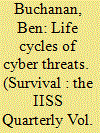

|
|
|
|
|
| Summary/Abstract |
Technology isn’t human, but it has stages of life. The period after the conception of a new piece of technology is often marked by significant investments of time and resources, often with little tangible return. If this work is successful, the technology begins to enter use, benefiting from iteration and design improvements. It may then begin to spread, gaining in popularity and begetting virtuous economies of scale. If all continues to progress, the technology will mature in the marketplace. Even if it attains market dominance, however, that position will not be permanent. In time, an upstart technology will appear on the scene, and the process will begin again. Sometimes the old technology will stick around in one form or another, carving out a niche role for itself. More frequently, it will be cast aside and supplanted.
|
|
|
|
|
|
|
|
|
|
|
|
|
|
|
|
| 16 |
ID:
096099
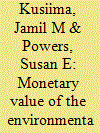

|
|
|
|
|
| Publication |
2010.
|
| Summary/Abstract |
This research is aimed at monetizing the life cycle environmental and health externalities associated with production of ethanol from corn, corn stover, switchgrass, and forest residue. The results of this study reveal current average external costs for the production of 1 l of ethanol ranged from $0.07 for forest residue to $0.57 for ethanol production from corn. Among the various feedstocks, the external costs of PM10, NOX, and PM2.5 are among the greatest contributors to these costs. The combustion of fossil fuels in upstream fertilizer and energy production processes is the primary source of these emissions and their costs, especially for corn ethanol. The combined costs of emissions associated with the production and use of nitrogen fertilizer also contribute substantially to the net external costs. For cellulosic ethanol production, the combustion of waste lignin to generate heat and power helps to keep the external costs lower than corn ethanol. Credits both for the biogenic carbon combustion and displacement of grid electricity by exporting excess electricity substantially negate many of the emissions and external costs. External costs associated with greenhouse gas emissions were not significant. However, adding estimates of indirect GHG emissions from land use changes would nearly double corn ethanol cost estimates.
|
|
|
|
|
|
|
|
|
|
|
|
|
|
|
|
| 17 |
ID:
117941
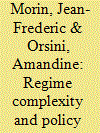

|
|
|
|
|
| Publication |
2013.
|
| Summary/Abstract |
This article looks at regime complexes from a state policymaking perspective. It develops a theoretical model in which regime complexes become
denser over time while governmental policymaking becomes more coherent. Underthis model, interactions between globalregime complexes and
national policymaking are twofold. On the one hand, greater policy coherence generates negotiated mandates asking for regime connections
and complex density. On the other hand, regime-complex density creates
more cohesive audiences, which increase incentives for national policy coherence. This co-adjustments model bringsstatesinto the discussion ofinstitutional interactions and critically questions the desirability and
feasibility of recent calls for joined-up government and whole-of-government approaches.
|
|
|
|
|
|
|
|
|
|
|
|
|
|
|
|
| 18 |
ID:
095587
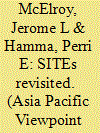

|
|
|
|
|
| Publication |
2010.
|
| Summary/Abstract |
This study attempts to do three things: (i) provide a review of recent advances in the small island economy literature using the tourism penetration index, (ii) update the impact of tourism across the same global sample of 36 small islands (less than 1 million in population and 5000 km2 in area) introduced in APV 47 (1) 2006, and (iii) employing an abbreviated version of the destination life cycle as a development paradigm, construct three different socioeconomic and demographic profiles based on low, intermediate and high tourism impact. Results using cross-sectional data of 27 indicators reveal three statistically distinct profiles that demonstrate three stages of economic development. Specifically, the findings contrast the low-income, labour-exporting, least tourism-penetrated MIRAB-type (Migrant/Remittances and Aid/Bureaucracy) emerging islands with their more advanced intermediate impact neighbours. In turn, the latter fall at a significant distance from the most successful small island tourist economy (SITE) destinations. Thus, this study further refines the characteristics of SITE islands and confirms the viability of tourism in general and the destination life cycle in particular as an effective engine and model, respectively, of island development.
|
|
|
|
|
|
|
|
|
|
|
|
|
|
|
|
| 19 |
ID:
181844


|
|
|
|
|
| Summary/Abstract |
This article builds on the theoretical debate over age, period, and cohort effects (APC) and explores how these factors might affect Taiwan's partisan stability. We conducted a two-level multinomial logit random effects model using survey data from 1991 to 2020 to disentangle the APC effects. Our findings challenge Converse's core assumption that partisanship strengthens with age. As a new democracy, Taiwan's party affiliations remain fluid, and we do find evidence of period effects, particularly associated with cross-Strait crises that favor the DPP. However, generational replacement is the most significant factor driving party identity changes in Taiwan. With generational replacement, the Kuomintang is burdened by the image of a century-old party. The Democratic Progressive Party (DPP) had previously fared better among young cohorts but has recently lost its support from millennials. The youngest generation increasingly refuses to associate with the traditional political parties. It seems reasonable to expect that the new generational forces will restructure the Blue–Green cleavage and expand the ideological diversity of Taiwan's party system.
|
|
|
|
|
|
|
|
|
|
|
|
|
|
|
|
|
|
|
|
|